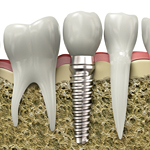
Periodontics is really the study of the supporting structures of the teeth. So that involves the tissue, the gums that involves the periodontal ligament that holds the teeth into place within their socket, and that also involves the bone. So periodontics is doing a crown lengthening procedure. A crown lengthening procedure is a matter of cutting away a little bit of tissue, like for instance, if a patient has very, very short teeth when they smile, sometimes that a case where there’s just too much tissue. And by cutting back the tissue and sometimes the bone that underlies the tissue in order to create a more aesthetic look.
Another case is when you’re restoring a tooth with a crown or possibly filling but the initial decay on that tooth, or the initial fracture, fractured below the gum line and close to the bone, in those cases in order to avoid a situation where you have chronic inflammation because the body is sending the signal that there is something foreign in the mouth because possibly a filling is too close or there are certain dimensions that have to be met in order to have the supporting structures of the tooth in harmony.
So in some cases, if that filling or crown infringe in that dimension then you get an area of chronic inflammation. So in those cases I would recommend to a patient to do a crown lengthening procedure to lengthen that area and cut back the tissue and the bone. And then in other cases, periodontics is a matter of placing implants. Sometimes it’s a matter of doing sinus lifts or bone grafts or deep scalings, so patients that have periodontists or gum disease.
Gum disease directly affects the supporting structures of the teeth so periodontics would be to do a deep scaling in that area, it’s important to get all the way underneath the tissue and remove that tartar and calculus that’s built up under the tissue to help that area heal.

























